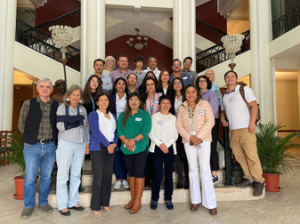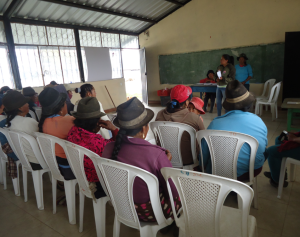This is a special edition by GFSI faculty and guest author: Dr. Jeanette Andrade, Assistant Professor and MS/DI Director, Food Science and Human Nutrition Department.
IGNITE Project: Improving Food Systems for School Nutrition in the Andean Region
Globally, resource-insufficient countries are experiencing a nutritional shift from a predominance of problems of undernutrition, including micronutrient deficiencies, stunting, and wasting, to

more complex situations characterized by a rapid increase in health problems associated with overnutrition, such as obesity, diabetes mellitus (DM), hypertensive disease and other non-communicable diseases. These health issues largely impact Indigenous communities within the Andean regions of Bolivia, Colombia, Ecuador, and Peru, predominately among children and adolescent females (Carrillo-Larco, et.al., 2020; Forste 2022; Galarza, et.al., 2021; Godfrey, et.al., 2010; Halfon, et.al., 2014; Jimenez-Mora, et al., 2023). The food systems, especially in schools, play a crucial role in these health issues as they influence the availability, accessibility, affordability, and quality of food (Global Panel on Agriculture and Food Systems for Nutrition, 2020).
The food that is available and accessible to the indigenous communities has evolved from locally grown and minimally processed, to externally obtained and highly processed, which are often nutrient-poor and energy-dense (Seyfang, 2006). Moreover, other factors affecting the food systems include water quality, soil health, and limited financial crop stability (Choque-Quispe, et.al., 2021; Winton, et.al., 2023). Currently, grassroots agroecological movements are leading efforts to improve knowledge and behavior toward consuming locally grown and sourced foods within rural Indigenous communities to improve health and nutritional outcomes with limited success reported (Deaconu, et al. 2021). A well-functioning school food system can contribute to better health and nutritional outcomes in several ways such as improving food and nutrition security, as well as being responsive and flexible to cross-cutting context considerations such as improving gender dynamics, enhancing cultural and social awareness, and improving sustainability of the food systems.

To have a well-functioning school food system, it is critical to determine methods and strategies to address barriers that may reduce the functioning of the school food system and lead to poor health outcomes.
So, what are we doing?
In Summer 2024, with the generous support of Global Food System Institute (GFSI), I had the pleasure of working with a team from the University of Florida – Dr. Juan Andrade Laborde, associate professor of global nutrition, and Dr. Kathleen Colverson, associate research scientist and gender expert, and Dr. Trent Blare, Manager of Centro Internacional de la Papa (CIP) in developing a symposium to address the question, “ What are the drivers of poor health and nutrition especially among school-aged children and female adolescents from indigenous groups?” To accomplish this question, we conducted a one-day symposium in Quito, Ecuador, and a one-day symposium in Lima, Peru.
In this symposium, we had a total of 36 attendees from organizations and education institutions to help address this question with the guidance of the Theory of Change. The Theory of Change is based on the premise of identifying barriers to long-standing problems along with solutions and strategies to improve outcomes. In the first part of the symposium, we had experts present their thoughts on barriers and strategies that have improved aspects of the school food system. In the second part of the day, we grouped attendees and had them discuss the above question and present barriers. We then identified themes from the barriers and had each group reconvene and discuss possible solutions.

The commonality of these barriers in both countries were: poor water quality and quantity, migration that increases the burden on the female who is the head of household, and limited access to a diverse diet. Some of the proposed solutions were to enhance the local/government policies, increase the affordability of local foods (or at least diversify the diet by fortifying foods), and increase the education/training of youth and females when migration may occur, to enhance the overall financial and well-being of the household.
Through the discussions that occurred, one of the conclusions was that working with established groups in both countries that are making inroads (e.g., FLACSO, EkoRural, WFP, CIP, IIN) and the nutrition groups working with the local governments could be a good choice to create partnerships that can support the improvement the school food system environments.
Overall, the insights gained from this excursion fostered more fruitful discussions on how UF and GFSI can assist organizations, institutions, and communities in Latin America. These efforts not only emphasize the food systems but also can aid in building long-lasting relationships that expose faculty and students to global issues.
References:
Deaconu, A., Berti, P.R., Cole, D.C., Mercille, G., Batal, M., 2021. “Market Foods, Own Production, and the Social Economy: How Food Acquisition Sources Influence Nutrient Intake among Ecuadorian Farmers and the Role of Agroecology in Supporting Healthy Diets.” Sustainability,13, 4410. doi.org/10.3390/su13084410.
Forste, R., 2022. “Maternal and child health in the Andean region.” In Healthcare in Latin America (David S. Dalton, Douglas J. Weatherford, Eds). University Press of Florida. doi.org/10.5744/florida/9781683402619.003.0013
Galarza, E., Cabrera, M., Espinosa, R. et al. Assessing the Quality of Amazon Aquatic Ecosystems with Multiple Lines of Evidence: The Case of the Northeast Andean Foothills of Ecuador. Bull Environ Contam Toxicol 107, 52–61 (2021). https://doi.org/10.1007/s00128-020-03089-0
Global Panel on Agriculture and Food Systems for Nutrition. 2020. Foresight 2.0. Future Food Systems: For people, our planet, and prosperity. Available online at: https://www.glopan.org/foresight2/
Godfrey, K.M., P.D. Gluckman, and M.A. Hanson, 2010. “Developmental origins of metabolic disease: life course and intergenerational perspectives”. Trends in Endocrinology & Metabolism, 21(4): p. 199-205.
Halfon, N., et al., 2014. “Lifecourse health development: past, present and future”. Maternal and Child Health Journal, 18(2): p. 344-365.
Instituto nacional de estadistica y censos. 2018. “Salud, salud reproductiva y nutricion.” Retrieved at https://www.ecuadorencifras.gob.ec/salud-salud-reproductiva-y-nutricion/
Seyfang, G., 2006. Ecological citizenship and sustainable consumption: Examining local organic food networks. Journal of Rural Studies, 22(4): p. 383-395.
Winton, R. S., López-Casas, S., Valencia-Rodríguez, D., Bernal-Forero, C., Delgado, J., Wehrli, B., and Jiménez-Segura, L., 2023. “Patterns and drivers of water quality changes associated with dams in the Tropical Andes.” Hydrology and Earth System Sciences, 27, 1493–1505, https://doi.org/10.5194/hess-27-1493-2023, 2023.
 1
1
